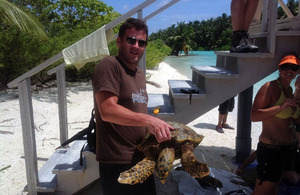Navy submariners help marine life research in Indian Ocean
Royal Naval submariners from nuclear-powered HMS Trenchant recently gave marine life experts a helping hand with an environmental project on the Indian Ocean island paradise of Diego Garcia.

Lieutenant Commander Dan Simmonds handles a hawksbill turtle at Turtle Cove [Picture: Crown Copyright/MOD 2012]
The hunter-killer vessel paid a rare visit to the remote British overseas territory of Diego Garcia, tagging rare marine life and celebrating the traditional naval ceremony of Crossing the Equator.
Enjoying a six-day break on the remote atoll after the latest patrol in their lengthy east of Suez deployment, the 130 crew of the Devonport submarine were the first British submariners to call in at the base in five years - and made the most of it.
While the boat was stocked up on supplies and underwent a spot of maintenance, some of her crew offered to help Swansea University researchers Professor Graeme Hays and Nicole Esteban, who are studying the behaviour and population of turtles in the British Indian Ocean Territory.
By day the sailors joined in expeditions to find and tag indigenous hawksbill turtles, and by night they sought to tag migratory green turtles which return to the island every few years to lay their eggs.
In recent years marine life experts have noticed an increase in numbers at the appropriately-named Turtle Cove, a rise attributed to the long-term protection afforded the turtles of the Chagos Archipelago.
A range of data-logging transmitters are fitted to the turtles, sending back data which reveals their patterns of behaviour. The creatures feed during the day and sleep on the seabed at night, diving for up to 45 minutes between breaths.
Night expeditions looking for nesting green turtles found eight of the animals, which were fitted with satellite tags. The turtles ranged in shell length from 101-115cm (39-45in) and weighed at least 136-158kg (300-350lbs).
Once the turtles left the island, they swam west; two have already been tracked to several hundred miles away with approximate positions from the initial data sent back.
Also on the nesting beaches sand temperatures are being monitored for the next year so researchers can predict the proportion of male and female hatchlings being produced on the beaches.
A team of four sailors - Lieutenant Commander Stuart Barrie, Warrant Officer Class 2 Frank Shirnhofer, Leading Seaman Damien Sheperson and Leading Seaman Gareth Arnold - joined Professor Hays and Nicole on a late-night expedition on the seaward side of the island looking for the nesting turtles.
Lt Cdr Barrie said:
The turtles wait for a high tide so that they can get onto the beach over the reef, then move up the beach into the undergrowth to find a suitable place to nest.
Once they have laid their eggs they cover them with sand before leaving the beach, heading away from the island. We found two sets of tracks, then traced them to a fresh nest on the beach. The experience was remarkable.
LS Arnold thoroughly enjoyed the chance to work beside the academics. He said:
The experience of working at night with the team was amazing and I would like to thank them again for letting us take part.
The boat’s Commanding Officer, Commander Irvine Lindsay, joined the daytime tagging party, helped recover the largest turtle, and took it to a measuring station at Turtle Cove, where readings were recorded and the animal tagged.
He said:
I have been lucky enough to get involved in an international research project investigating the lives of sea turtles. This was a once-in-a-lifetime opportunity.
Although principally a US naval and air base, Diego Garcia is UK soil with a small contingent of British military personnel based on the island. While there, many of the ship’s company took the opportunity to enjoy the sailing, fishing, windsurfing, snorkelling and kayaking on offer after a protracted period at sea.
The respite finally allowed the men of HMS Trenchant to carry out the traditional Royal Naval ceremony of Crossing the Equator; the island is seven degrees south of the Equator. More than 60 novices who’d never crossed the imaginary line before, including the ship’s mascot, were summoned to appear before the court of King Neptune (played by the captain) and then dunked in water.
Cdr Lindsay summed up the stopover as:
an ideal location to unwind, play some sport and take in the breathtaking scenery. The visit has proved the ideal opportunity to recharge our batteries and prepare us for the next stage of our deployment.